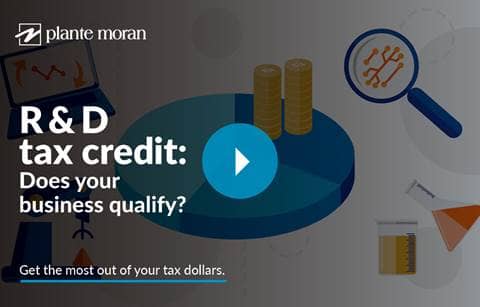Businesses that qualify to claim the federal tax credit for increasing research activities (R&D credit) will be able to claim a credit against Michigan taxes for qualifying expenses incurred for research conducted in the state effective for tax years beginning on or after Jan. 1, 2025. In an effort to reposition Michigan as a leader in research and innovation, House Bills 5100 (Public Act 186 of 2024) and 5101 (Public Act 187 of 2024) reestablish a Michigan R&D tax credit. The credit is available to corporations and pass-through entities and will be subject to limitations based on the tentative credit claims statewide. The maximum credit available to entities will also be limited based on the total number of individuals employed by the taxpayer. Here’s an overview of this new tax incentive.
Key terms based on federal R&D credit rules
The Michigan law looks to the Internal Revenue Code (IRC) to decide which expenditures qualify for the credit. Here’s a quick review of the federal rules. The first step is to determine if the activity in question meets the IRC definition of R&D, which is based on four criteria:
- Is the activity intended to develop a new product or process or to improve the function, performance, reliability, and/or quality of a product or process?
- Is there technical uncertainty involved — is it even possible to develop and/or improve the product or process in question? If it’s possible, is there uncertainty related to the appropriate design or method used to develop the product or process?
- Is experimentation required? The uncertainty involved must lead to testing or analysis that evaluates alternatives.
- Is the activity technological in nature and based in science, such as biology, chemistry, computer science, or engineering?
If the activity meets the criteria to qualify as R&D, the following four categories of expenses will qualify for the credit:
- Wages for any employee directly performing, supporting, or supervising the R&D activities.
- Supplies used in the process of experimentation, such as prototypes or raw materials.
- Expenditures for rental of off-site and cloud-based server space for design or testing of new or improved software.
- Expenses associated with outside service providers used during the research process, including contract engineers, consultants, developers, outside lab testing, and the like.
Once the qualified expenses are determined for the year, they’re compared to a federal “base amount,” which is the average spent on those activities over the last three years. If the amount spent in the current year is more than half of the three-year average, the taxpayer generates a federal credit.
Calculating the Michigan R&D credit
To calculate the Michigan credit, taxpayers must identify the eligible research expenses that were incurred to conduct research in Michigan. The process involves calculating the current-year Michigan expenses, as well as a Michigan-specific base amount. Fiscal year taxpayers will be required to determine these amounts on a calendar year basis.
Taxpayers can claim a credit for those Michigan expenses as follows:
- Large taxpayers (more than 250 total employees) can claim a credit amount equal to 3% of qualifying expenses up to the base amount plus 10% on expenses in excess of the base amount. The maximum credit available to these taxpayers will be $2 million per year.
- Small taxpayers (less than 250 total employees) can claim a credit amount equal to 3% of qualifying expenses up to the base amount plus 15% on expenses in excess of the base amount. The maximum credit available to these taxpayers will be $250,000 per year.
Both large and small taxpayers can claim an additional 5% credit by incurring qualifying expenses for research performed in collaboration with an eligible Michigan research university, up to a maximum additional credit of $200,000 per year.
Administrative processes for claiming Michigan’s R&D credit
Taxpayers who want to claim the R&D credit for 2025 must file an application with the Michigan Department of Treasury before April 1, 2026. This includes both calendar year and fiscal year taxpayers. For credits claimed in subsequent years, the deadline will move up to March 15. The application form is separate from the business tax return, and it serves to notify the state of the total claims expected for the year.
That advance notification is important because the total Michigan R&D credits amount that all taxpayers can claim statewide is capped at:
- $75,000,000 for large taxpayers.
- $25,000,000 for small taxpayers.
If the total credits applied for by all taxpayers statewide exceed the capped amounts above, all credits will be awarded to taxpayers on a pro rata basis, and the department will notify taxpayers via its website regarding any adjustments to their claims.
To claim the credit, taxpayers that pay corporate income tax (CIT) will claim the adjusted credit amount on the CIT return for the tax year for which the credit is claimed. This means that taxpayers will need to extend their Michigan CIT returns and wait to file after the final claim amounts are posted by the state.
Flow-through entities will claim the credit on their sales, use and withholding annual returns, which are due on Feb. 28, 2027. However, as soon as the tentative claim adjustment notice is released, flow-through entities have the option to adjust their associated withholding payments. Taxpayers interested in taking this approach will need to work closely with their payroll tax providers to properly implement this option.
Claimed credits that exceed the entity’s tax liability may not be carried back or forward for use in a different tax year. However, the credits may be refundable if claimed after all other nonrefundable credits.
Michigan decouples from IRC Section 174(A): Why the R&D credit matters more now
On Oct. 7, 2025, HB 4961 was signed into law, which updated Michigan’s conformity date with the Internal Revenue Code. As a result, Michigan has decoupled from the federal changes to IRC Section 174(A) regarding research expense treatment. While the One, Big, Beautiful Bill restored immediate expensing of domestic research and experimental (R&E) costs at the federal level for tax years beginning on or after Jan. 1, 2025, Michigan will continue to require capitalization and amortization for these expenses over a five-year period.
This means businesses conducting R&D in Michigan may face higher state taxable income compared to their federal returns, as they can’t immediately deduct research costs for Michigan tax purposes. Instead, these costs must be spread out over multiple years, potentially increasing Michigan tax liability and reducing cash flow.
The new Michigan R&D credit helps offset this impact. With immediate expensing unavailable at the state level, the refundable credit provides a direct reduction of Michigan tax liability for qualifying R&D expenditures. For many taxpayers, this credit will be essential to restore some of the benefits lost due to the amortization requirements. Companies should prioritize tracking Michigan-specific R&D costs and consider the credit as a key part of their tax planning strategy.
Start planning now to track qualifying Michigan R&D expenses
With the new credit available for expenditures in the current calendar year, it’s a good idea to begin working with a tax advisor as soon as possible on modifications to R&D expense tracking systems that will help identify Michigan-specific costs, as well as any of those costs that relate to collaboration with Michigan research universities. Because the base amount needed to determine the amount of the 2025 credit requires calculation of Michigan-based R&D expenditures in the previous three years, taxpayers may need to apply the modifications to their R&D calculations for several years prior to 2025. Fiscal year taxpayers will also need to determine the current year and prior year expenditures on a calendar year basis, which may require additional analysis.
Longer term, this new incentive points to a new economic strategy in Michigan, one that seeks to incentivize taxpayers to evaluate the potential benefit of moving R&D activities from other states into Michigan, and with the goal of factoring it into cost-benefit decisions when weighing where new R&D facilities will be built and where new high-tech and high-paying jobs will be offered.





